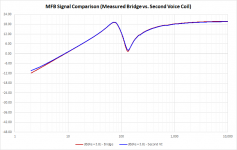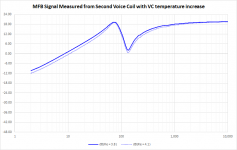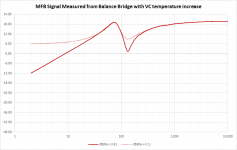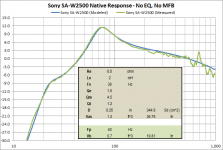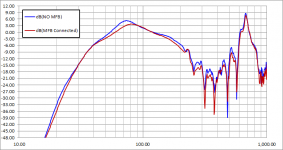http://www.roger-russell.com/wire/damptoole.htm[/url]
Pertinent, sort of.
In the piece, Tools is mocking the naive belief in the significance of low output impedance amps (that is, high damping factor). Absolutely right and many us laugh out loud hearing people talk about passive crossovers.
True, low output impedance is beneficial but it is no miracle cure for "group delay" in your BR box.
By contrast, an MF amp does not behave with low output impedance. It provides negative output impedance and that is not low either.
I went through the procedure that illustrates this on the test bench a few posts ago.
Ben
"...Room resonances at low frequencies behave as minimum-phase systems and properly matched parametric EQ can repair both the amplitude and time domain problems. Off-the-shelf automated "room EQ" or "room correction" programs may or may not be able to do this properly. Many do not..."
So, the right type of EQ applied correctly can be helpful. 🙂
Pity you didn't have a chance to read the article. He demonstrates the opposite point of view, namely that basic frequency ("amplitude") correction is not the right (or not the whole) way to achieve your perceptual house curve. He is hostile to relying on room EQ as the core approach to fixing rooms.
That's a shame because I think it is fair to say that all of us with a mic and DSP work that way.
Worth a read.
Ben
Wow, you really enjoy being a **** don't you?
The remark of mine you quote was obviously meant ironically. If you read perceptively, you know I am the guy with the oscilloscope on his bench, decades of instrument measurements, and megabits of REW data. My stated purpose in this thread is to find measurements that characterize MF quantitatively.
I welcome seeing your apology. There should be nobody sending in posts like yours which are purely personal attacks and have zero helpful content. It is against the rules.
Ben
Last edited:
Do I recall correctly that previously you presented a strong case against using simple series resistors as sensors? And that is a voice coil (back EMF) method which a lot of respected manufacturers (like Rhythmic and AceBass) seem to be using.I meant to mention the similarities between AceBass and Rythmik systems. If you look at the patents it becomes clear that the Rythmik circuit makes use of the same current feedback arrangement AceBass uses to manipulate effective mass and compliance. The one weakness in the AceBass system was the manipulation of damping by positive current feedback is adversely affected by voice coil temperature. For damping manipulation, Rythmik replaces the positive current feedback approach with negative velocity feedback from a second voice coil which is not affected by VC temperature.
Apropos your other post, I think we need a clear airing of the issue of MF applied to vented boxes. Seems that a lot of old timers (including me) are aghast at the thought. But you, and respected manufacturers, see no problem.
I suppose, inferring from your post, it depends on what aspect of speaker deficiency you are using MF to combat. If distortion or extreme X are concerns, then OK to use vented boxes, provided you have DSP power here and there. If smooth, "fast", and extended FR (which includes fighting resonances and boom) are your devil, then BR would not work with MF.
What do you think?
Ben
Last edited:
True, low output impedance is beneficial but it is no miracle cure for "group delay" in your BR box.
MF is no cure for group delay either. Bolsterst explained this back in post 171.
MFB doesn’t eat group delay, but it does modify response in a manner that reduces it. Group delay is the rate of change of phase…basically a measure of how quickly the phase is wrapping up or changing as you go down in frequency. The sharper the LF roll-off corner and the faster the rate of roll-off below the corner the quicker phase changes, so higher group delay. MFB flattens and extends the response and reduces the rate of roll off at the corner, all of which reduce phase rotation and group delay. With VC feedback, a roll off rate of only -3dB/oct is not uncommon for an octave or so below the corner.
Read that over a few times if you don't understand it right away. Group delay is related to phase, which in turn is related to frequency response. (Who would have known, all those graphs the simulator spits out are inter-related and quite useful at figuring out what's going on?)
What does this actually mean? If you had a theoretically ideal driver that had perfectly flat frequency response from 0 - a few octaves higher than the passband in a sealed box, that speaker would have flat phase response and zero group delay.
Outside of that theoretical ideal situation, we have speakers that do have changes in frequency response. Mild changes in frequency response cause mild changes in phase and mild amounts of group delay. Abrupt changes in frequency response cause abrupt changes in phase and large amounts of group delay.
Let's look at some sims, because I know you love sims. This is frequency response, phase and group delay of a sealed box (left column) vs an "audiophile approved" ported box with 11 hz tuning (right column). As you can see, frequency response is almost identical (probably could have made it even closer if I spent a few more minutes on it, but the sealed box response is overlaid and you can see it's pretty close as is), phase is pretty close, and group delay doubled but it's still only 15 ms at 10 hz. That's short enough in time and low enough in frequency that it's mostly if not completely inaudible.
If you made these two boxes and listened to them in a blind test you would not be able to tell them apart (assuming the baffle was the same size and shape so there's no diffraction differences, because the ported box is about 1/2 the size of sealed box.) Only at high power would you be able to tell a meaningful difference, and only because the ported box has way more max spl.
An externally hosted image should be here but it was not working when we last tested it.
When you consider the fact that room resonances can ring for several times longer than the group delay shown here, and at several frequencies, including frequencies that are much higher and much more sensitive to human hearing, I can't imagine why you keep talking about group delay like it's a huge problem.
IT'S NOT RESONANCES OR GROUP DELAY THAT MAKE PORTED BOXES SOUND BOOMY, IT'S BAD DESIGN.
Having said that, it can be a problem if you design a box with large amounts of group delay at a high frequency. Here's an example of lots of group delay, if this was happening above 40 hz it could be a problem.
An externally hosted image should be here but it was not working when we last tested it.
But make no mistake, MF can't fix ported box group delay. For that you would need flat phase which requires flat frequency response to frequencies well outside the passband. This is going to cause excursion problems whether you use MF or not.
So please stop talking about group delay, and especially about group delay being a euphemism for boom. Look at that first ported box sim and tell me it's going to sound boomy. Go ahead, I dare you.
Last edited:
Apropos your other post, I think we need a clear airing of the issue of MF applied to vented boxes. Seems that a lot of old timers (including me) are aghast at the thought.
And yet you had no qualms attempting to apply it to a Karlson 15 and a Klipschhorn, which have MULTIPLE resonances inside the passband, as well as frequency response, phase and group delay issues orders of magnitude worse than your average ported box. Stuff like this simply makes no sense at all.
If you read perceptively, you know I am the guy with the oscilloscope on his bench, decades of instrument measurements, and megabits of REW data.
I'm paying quite close attention and haven't seen any data of any kind presented by you. In fact you said you didn't measure anything when you tested MF at home on a variety of subs, and even subjectively you noticed little to no improvement despite being strongly biased about MF being the "final frontier". Repeatedly pointing at your resume and experience does nothing at all in lieu of actual data. You have NONE.
I recall making a case that VC feedback will never give you the distortion reduction of an accelerometer sensor. Perhaps that is what you are thinking of?Do I recall correctly that previously you presented a strong case against using simple series resistors as sensors?
Yes, that is it exactly. Using negative current feedback to manipulate effective mass and compliance works great and is stable. Using positive current feedback to manipulate damping to any great degree is troublesome because of the dependence on VC temperature. Negative VC feedback works great for manipulating damping, but does not have the linearity to reduce harmonic distortion except at the lower frequency extreme where suspension non-linearities may dominate. Using T/S manipulation is perfectly valid for vented box, even higher order boxes. Using velocity or acceleration feedback to directly control cone motion though, is only applicable to sealed box. And as you know if you use VC feedback, and force the cone velocity to be proportional to input voltage, you will need to put a 6dB/oct bass boost in the preamp upstream of the feedback loop to get a flat SPL response.I suppose, inferring from your post, it depends on what aspect of speaker deficiency you are using MF to combat.
The series resistor used by Ace-Bass and Rythmik does not sense back-EMF, it senses current thru the voice coil. So, this feedback signal is proportional to the force applied to the cone by the VC. Back-EMF is proportional to VC (and hopefully cone) velocity. Applied force and resulting velocity are different.Another reason to simply use a series resistor to sense back-EMF. Like ACE-Bass, eh. Or better, a bridge.
You bring up the bridge arrangement again, and I understand the appeal of possibly getting a signal proportional to cone velocity to use for MFB without any additional VCs or sensors. However, using a resistive bridge arrangement as you regularly recommend results in the same signal errors as the mutual coupling causes in the second VC arrangement unless you can perfectly balance the bridge for the VC inductance + lossy inductance. Attachment #1 shows a comparison. You can see they are virtually identical. I know you aren’t interested in models, so won’t bore you with the details of why this is. It has been pointed out often that the bridge arrangement is also subject to errors from VC heating which you have suggested must be small since you never noticed a problem. I ran tests in the past showing as much as 12dB errors below the peak velocity frequency after playing a bass intense movie sound track. Unfortunately I can’t seem to locate those measurements, and I doubt results of a model showing this effect would interest you. I did locate one set of measurements comparing the bridge vs. second VC signal that shows the sensitivity to just 0.3 ohm increase in VC resistance after playing a jazz trio track at moderate volume. Attachment #2 shows the second VC signal unaffected by change in VC resistance, still giving a signal proportional to VC velocity(note the response and velocity are reduced as VC resistance increases). Attachment #3 shows that the bridge is thrown well out of balance by even a 0.3ohm increase in VC resistance, already 4dB off at 20Hz.
Attachments
I have no doubt that your choice of design path should work to achieve your goals. My preference is to always minimize subwoofer enclosure size when possible to improve placement flexibility and reduce cabinet related noises.…THAT is the path to low distortion as far as I'm concerned, not MF. Of course that's not an option for people with cranky spouses or people living in small apartments but I don't have problems like that.
The implication of this statement is that you can’t hear the difference between a low/high distortion subwoofer or a low/high group delay subwoofer in an average room. I haven’t found this to be the case. The room certainly dominates the overall response, but harmonic and transient distortion from the sources is still noticeable. In particular, it seems to make the source more easily localized. You are correct that best results will be had with a well-treated room and a high performance source. However, I think improvements in either piece of the puzzle are worthwhile and one piece may be much easier to improve than the other.The third remaining factor, as I previously mentioned, is getting the room well treated. Until all that is done I'm not even moderately interested in considering MF.
How NOT to design a vented subwoofer
Ok, now for the promised levity…measurements of the Sony SA-W2500 “subwoofer”
Attachment #1: Here is measurements of port, piston, & summation made straight from the test computer, no EQ, no MFB, just woofer + box response. The port response looks more like what I’d expect to see from a 4th order bandpass design. I re-measured it 3 times thinking it must be wrong. Has anybody else seen anything like this before?
Attachment #2: I measured T/S parameters and modeled the response which, surprise surprise, matches the measurements. Yes, you are reading that correctly Sony is using a woofer with a Qts=1.2 in a ported box. Thank goodness for EQ 😉
Attachment #3: Here is a comparison of response as implemented with EQ, LP filter turned to its highest setting, and with/without MFB. You can see that the MFB loop gain is so low (~3dB) it might as well not even be there.
Ok, now for the promised levity…measurements of the Sony SA-W2500 “subwoofer”
Attachment #1: Here is measurements of port, piston, & summation made straight from the test computer, no EQ, no MFB, just woofer + box response. The port response looks more like what I’d expect to see from a 4th order bandpass design. I re-measured it 3 times thinking it must be wrong. Has anybody else seen anything like this before?
Attachment #2: I measured T/S parameters and modeled the response which, surprise surprise, matches the measurements. Yes, you are reading that correctly Sony is using a woofer with a Qts=1.2 in a ported box. Thank goodness for EQ 😉
Attachment #3: Here is a comparison of response as implemented with EQ, LP filter turned to its highest setting, and with/without MFB. You can see that the MFB loop gain is so low (~3dB) it might as well not even be there.
Attachments
Last edited:
The implication of this statement is that you can’t hear the difference between a low/high distortion subwoofer or a low/high group delay subwoofer in an average room.
I would like to respectfully disagree with this. Using high quality drivers in a good design as part of a properly sized system will yield low distortion subwoofers when used in their linear operating range regardless of whether you use MF or not. I'm going to have to throw your own quote back at you.
"... in the past 10 years or so I think MFB has become a solution in search of a problem. Modern FEM modeling techniques for mechanical /magnet/electrical systems have made it possible to improve woofer performance to the point that there is little to be gained except when it is desired to push a woofer beyond its inherent linear range in search of higher SPL (without increasing size or number of woofer)."
This statement implies that there is no reason why a non MF speaker would be inherently high distortion and you've made several similar statements.
Furthermore, group delay has nothing to do with anything, I just showed a sealed and ported box with remarkably low group delay. And we can alter group delay by changing frequency response with eq so a non MF speaker doesn't inherently have worse group delay than one that uses MF. I already talked about that in my last long post with the sims, and you talked about group delay in the quote from that post.
I haven’t found this to be the case. The room certainly dominates the overall response, but harmonic and transient distortion from the sources is still noticeable. In particular, it seems to make the source more easily localized.
Can you get moderately better behaved cone motion with MF? Sure, but again I have to point back to your quote above - it simply isn't a big problem in the first place. Therefore it's very far down on my list of things to fix.
You are correct that best results will be had with a well-treated room and a high performance source. However, I think improvements in either piece of the puzzle are worthwhile and one piece may be much easier to improve than the other.
I don't disagree but some things have a lot more benefit than others, this is easily audible and measurable.
As far as which is easier to implement than the other - I've seen probably hundreds of treated rooms and zero successful MF projects. Maybe that's because I look at things that interest me and I don't find MF all that interesting. But on the other hand, our resident MF expert has had hifi aspirations since 1956, he's been talking about MF since he joined the forum in 2008, he says he's got all the parts to implement MF, he says he's got the equipment to measure it and he says he's got the experience to build and measure it. But he doesn't MF and it appears he's nervous to even glue the accelerometer to the driver. I'm not an electronics guy, I'm a diy speaker guy. As far as I remember you are the only one that has posted measurements of anything and none of the MF proponents in this discussion can even agree on what type of MF to implement. (For the record my money would be on you, if we could get anyone to actually build and measure anything.)
So considering all that I'd have to say room response is way easier to implement via treatments than MF, and will have vastly greater benefits.
To add a bit more perspective from a personal point of view, here's an overview of my bedroom system. It's very simple, just a Technics amp, Klipsch Heresy II speakers and a listening spot about 6 feet from the speakers. No sub.
I don't have an spl meter, but the vast majority of listening in this room is at night with the volume control at 2. I have to turn it up to 7 to get the 0.01 watt light on the power level meter to flicker. I've NEVER seen the 10 watt light illuminate.
This is what I consider a properly sized system.
It's been mentioned several times that the primary benefits of MF are:
- reduced distortion in the driver's non linear region (not so much at low spl)
- ability to use smaller box sizes
- ability to get the most out of cheap drivers
- ability to manipulate effective t/s parameters
- ability to improve frequency response (and group delay as a result)
- GOOD LOOKING TONE BURSTS !!!!!
Did I miss any of the major ones?
I have no problem with the distortion, tone burst shape or box size of the speakers I use at the spl level I use them. If I wanted to modify the frequency response (along with the resultant group delay changes) I would use the eq built into my source (laptop) or pull an equalizer out of the closet and hook it up.
If I was going to build new speakers for this application I would use high quality drivers with t/s parameters that are suitable for the design goals and spl capability way higher than I would ever need.
Not a single one of the MF benefits are useful to me in any way in this system. I doubt my distortion levels ever reach higher than very low single digits, maybe a couple percent at most. How much distortion do you get from high efficiency drivers moving a fraction of a mm (I can't measure right now)? How much could MF benefit this situation?
Those are my thoughts on a properly sized system and why MF is not really useful to me due to my design philosophies, which first and foremost dictate low distortion at spl as high as I need it to go by means of properly sizing the system and using quality components.
For people that find the benefits of MF interesting and are willing to spend time and money pursuing these benefits, that's fine, but I think it's clear that we don't share the same system design philosophies.
(Yes I know Heresys are hardly perfect but they do what I need them to do and they were free. Also rock/alternative type music without much bass sounds FANTASTIC and fun on these.)
I don't have an spl meter, but the vast majority of listening in this room is at night with the volume control at 2. I have to turn it up to 7 to get the 0.01 watt light on the power level meter to flicker. I've NEVER seen the 10 watt light illuminate.
This is what I consider a properly sized system.
It's been mentioned several times that the primary benefits of MF are:
- reduced distortion in the driver's non linear region (not so much at low spl)
- ability to use smaller box sizes
- ability to get the most out of cheap drivers
- ability to manipulate effective t/s parameters
- ability to improve frequency response (and group delay as a result)
- GOOD LOOKING TONE BURSTS !!!!!
Did I miss any of the major ones?
I have no problem with the distortion, tone burst shape or box size of the speakers I use at the spl level I use them. If I wanted to modify the frequency response (along with the resultant group delay changes) I would use the eq built into my source (laptop) or pull an equalizer out of the closet and hook it up.
If I was going to build new speakers for this application I would use high quality drivers with t/s parameters that are suitable for the design goals and spl capability way higher than I would ever need.
Not a single one of the MF benefits are useful to me in any way in this system. I doubt my distortion levels ever reach higher than very low single digits, maybe a couple percent at most. How much distortion do you get from high efficiency drivers moving a fraction of a mm (I can't measure right now)? How much could MF benefit this situation?
Those are my thoughts on a properly sized system and why MF is not really useful to me due to my design philosophies, which first and foremost dictate low distortion at spl as high as I need it to go by means of properly sizing the system and using quality components.
For people that find the benefits of MF interesting and are willing to spend time and money pursuing these benefits, that's fine, but I think it's clear that we don't share the same system design philosophies.
(Yes I know Heresys are hardly perfect but they do what I need them to do and they were free. Also rock/alternative type music without much bass sounds FANTASTIC and fun on these.)
Last edited:
One more example of a properly sized system with real world product and cost comparison, because no matter how many times I say "properly sized system" I feel people are not inferring what I'm implying.
MF System, $769, shipping not included
1x Rhythmic DS1510 4ohm sealed 3-4 cu ft , with H600PEQ3 servo amplifier
1.21 liters displacement (Sd x xmax), 600 watt amp with 1 band peq
Non MF System, $756, free shipping for amp, shipping not included for drivers
3x Stereo Integrity HT 18 (currently discontinued but coming back soon at $159 each)
1x Inuke 3000 DSP (available anywhere for $279 regular price with free shipping, often avaiale on sale for less)
7.95 liters total displacement (Sd x claimed xmax x 3 drivers), 3000 watt amp with full dsp
The Rhythmic kit has to go in the manufacturer recommended 3-4 cu ft box, the SI drivers would ideally be in infinite baffle for best performance.
Wreckingball claimed that the Rhythmic kits were priced on par with non MF products but which one of these packages sounds like the better value? Which one of these packages would have measurably lower distortion at any spl level and which one would have vastly greater max spl?
I'd like to see anyone argue that the Rhythmic kit is better in any way than 3 high excursion 18s in infinite baffle with 3000 watts and full dsp behind them. For the same price the non MF package will slaughter the Rhythmic kit in every performance metric except maybe tone burst shape. The three 18s would also actually have a smaller physical enclosure than the Rhythmic sealed box, since they only need a small manifold when used in IB, so the MF = smaller size argument is not valid in this case either.
Properly sized system for the win and there's literally no downside.
MF System, $769, shipping not included
1x Rhythmic DS1510 4ohm sealed 3-4 cu ft , with H600PEQ3 servo amplifier
1.21 liters displacement (Sd x xmax), 600 watt amp with 1 band peq
Non MF System, $756, free shipping for amp, shipping not included for drivers
3x Stereo Integrity HT 18 (currently discontinued but coming back soon at $159 each)
1x Inuke 3000 DSP (available anywhere for $279 regular price with free shipping, often avaiale on sale for less)
7.95 liters total displacement (Sd x claimed xmax x 3 drivers), 3000 watt amp with full dsp
The Rhythmic kit has to go in the manufacturer recommended 3-4 cu ft box, the SI drivers would ideally be in infinite baffle for best performance.
Wreckingball claimed that the Rhythmic kits were priced on par with non MF products but which one of these packages sounds like the better value? Which one of these packages would have measurably lower distortion at any spl level and which one would have vastly greater max spl?
I'd like to see anyone argue that the Rhythmic kit is better in any way than 3 high excursion 18s in infinite baffle with 3000 watts and full dsp behind them. For the same price the non MF package will slaughter the Rhythmic kit in every performance metric except maybe tone burst shape. The three 18s would also actually have a smaller physical enclosure than the Rhythmic sealed box, since they only need a small manifold when used in IB, so the MF = smaller size argument is not valid in this case either.
Properly sized system for the win and there's literally no downside.
Last edited:
It's been mentioned several times that the primary benefits of MF are:
- reduced distortion in the driver's non linear region (not so much at low spl)
- ability to use smaller box sizes
- ability to get the most out of cheap drivers
- ability to manipulate effective t/s parameters
- ability to improve frequency response (and group delay as a result)
- GOOD LOOKING TONE BURSTS !!!!!
Having heard three different models of Philips MFB loudspeakers (one three-way and 2 two-way) I agree with you on all your points, including additional one - use of small woofer drivers. Philips MFB are very small boxes, something which can be very important to someone who doesn't have a space for two big boxes like Klipsch Heresy.
Advice to all Philips MFB users: tweeter is too obvious, adjust the high-gain trimmer.
Very nice to see data, esp so orderly and meaningful. It illustrates very well a number of issues addressed in this thread.Attachment #3:[/b] Here is a comparison of response as implemented with EQ, LP filter turned to its highest setting, and with/without MFB. You can see that the MFB loop gain is so low (~3dB) it might as well not even be there.
1. Commercial systems tend be conservative in how much feedback to apply, (which is smart enough) even when Sony is controlling the whole ball game. A DIYer would prolly use more and prolly avoid a BR box.
2. Even with just 2-3 dB feedback, MF is working as advertised at least modestly. The peaks are tamed and the bass is extended and flattened (25-100 Hz, which would be more obvious if the MF curve were cranked up by 2-3 dB to illustrate that). Too bad there aren't distortion and tone burst data.
3. Good to see the BR driver, port, and total plotted. Fans of BR boxes can see the BR characteristics nicely demonstrated (including the 18 dB rolloff and the antagonism of port and cone outputs). Given the difference between the motion of the cone versus total output of a BR box, it should be obvious why the old-timers don't see the logic of applying cone motion sensing MF (VC or accelerometer) to a BR box... even if it sort of helps a bit with this Sony.
Again, thanks.
Ben
Last edited:
The damping factor of an amp increases as its output impedance decreases.Pertinent, sort of.
In the piece, Tools is mocking the naive belief in the significance of low output impedance amps (that is, high damping factor). Absolutely right and many us laugh out loud hearing people talk about passive crossovers.
True, low output impedance is beneficial but it is no miracle cure for "group delay" in your BR box.
By contrast, an MF amp does not behave with low output impedance. It provides negative output impedance and that is not low either.
I went through the procedure that illustrates this on the test bench a few posts ago.Ben
When the amp output impedance approaches 0 Ohm, the damping factor tends to be infinite.
So if the amp outpout impedance is negative, meaning less than 0 Ohm, the value of the damping factor should be more than infinity.
I always considered damping factor as a fallacious notion avoiding to have the right picture of the amp-loudspeaker system.
A funny thing is to think of the damping factor of an amp having a negative output impedance.
Having heard three different models of Philips MFB loudspeakers (one three-way and 2 two-way) I agree with you on all your points, including additional one - use of small woofer drivers. Philips MFB are very small boxes, something which can be very important to someone who doesn't have a space for two big boxes like Klipsch Heresy.
Advice to all Philips MFB users: tweeter is too obvious, adjust the high-gain trimmer.
I was actually arguing that none of those benefits are of any use to me.
Klipsch Heresy are not large speakers. A lot of people actually think they are bookshelf size. Here's a bunch of links to people talking about Klipsch Heresy bookshelf speakers including retailers and a professional review.
Klipsch Heresy III Bookshelf (surround) loudspeakers - pair price - RMS-store.eu - Hi-Fi Home Cinema Audio-Video Gigawatt
https://www.popscreen.com/prod/OTgx...sy-Bookshelf-Speakers-rare-and-beautiful-eBay
https://community.klipsch.com/index.php?/topic/129758-heresy-best-bookshelf-ever-made/
Klipsch Heresy III Loudspeaker | The Absolute Sound
People that think the Heresy is too large are obviously not on the same page as me. I prefer higher efficiency moderate/large enclosures and keeping excursion well below xmax vs stuffing a driver in an undersized box and forcing it to behave when pushed to it's physical limits by further abusing it and boosting the power to correct for extreme excursion and thermal non linearities. There's a popular expression about putting 10 pounds of stuff in a 5 pound bag.
If size is such an insurmountable issue put the drivers in the wall. Speakers can use the wall cavity as a box (which also provides significant advantages due to diffraction which includes boundary reinforcement gain) and subwoofers can be flush or manifold mounted using an adjacent space as an infinite baffle enclosure. Both of these take up near zero space in your room.
Last edited:
A funny thing is to think of the damping factor of an amp having a negative output impedance.
Funny, even weird, but true.
I recall measuring -2 Ohms hiding inside a bridge sensor MF amp for a DF of -16.
When the speaker says "Give me more juice"* the gremlin inside the amp says "Nuts to you, I will give you LESS. You just want that juice so you can flop about and boom more".
And that is how MF works. As bolserst chart shows.
B.
*Canadian systems always say, "Please give me more..."
Last edited:
I meant to mention the similarities between AceBass and Rythmik systems. If you look at the patents it becomes clear that the Rythmik circuit makes use of the same current feedback arrangement AceBass uses to manipulate effective mass and compliance. The one weakness in the AceBass system was the manipulation of damping by positive current feedback is adversely affected by voice coil temperature. For damping manipulation, Rythmik replaces the positive current feedback approach with negative velocity feedback from a second voice coil which is not affected by VC temperature.
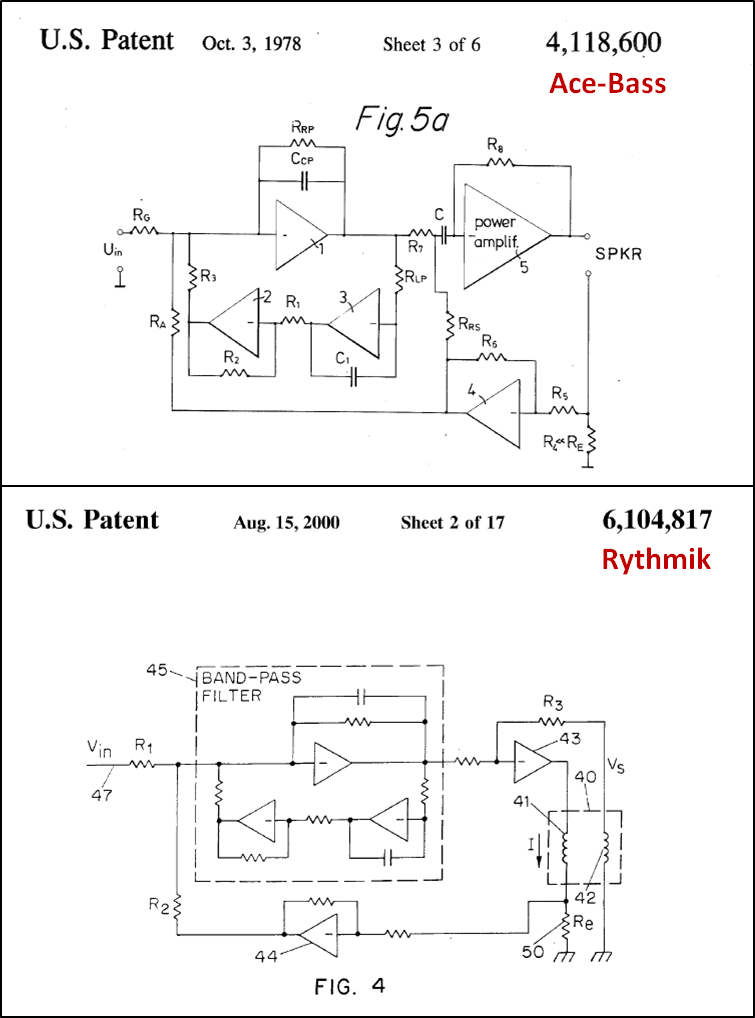
Thanks for this one. I was always puzzled by how a coil-velocity feedback could be applied to a bass-reflex.
For the ACE-bass like, Ian Hegglun (1) has proposed to replace the current sensing resistor by a resistor put in the vicinity of the magnet and having a a similar thermal behaviour as the voice coil.
This seems to have been largely exploited by Yamaha.
However, I think using a standard resistor prevents bolting of the positive feedback loop.
(1) Ian Hegglun "Speaker feedback"
Electronics World, May 1996, pp378-382.
The same article shows a modification of the Sokol's adjustable transform circuit for drivers in closed box.
- Home
- Loudspeakers
- Subwoofers
- Commercial motional feedback woofer available sort of
